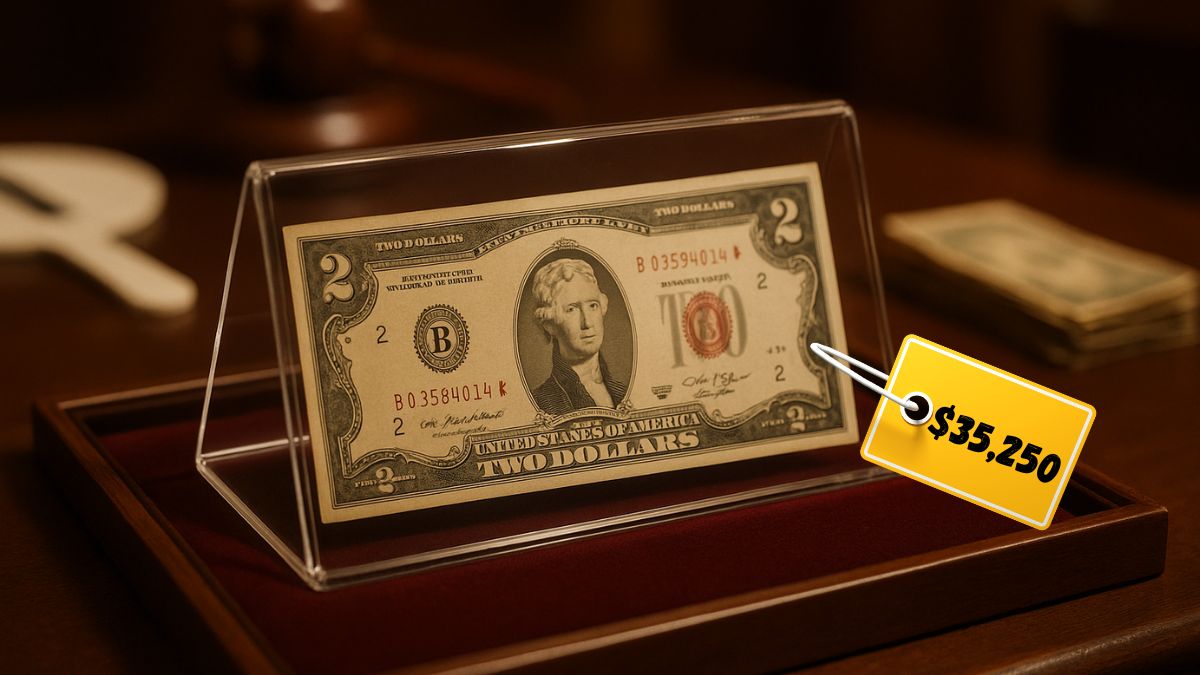A rare 1976 $2 bill recently sold at auction for an astonishing $35,250, capturing the attention of collectors and enthusiasts alike.
While most 1976 $2 bills are worth their face value, certain unique features can elevate their worth exponentially. This article delves into the specifics of this exceptional bill, exploring the factors that contributed to its high value.
The 1976 $2 Bill: A Bicentennial Commemoration
In 1976, to celebrate the United States’ Bicentennial, the Treasury Department reintroduced the $2 bill. The obverse featured Thomas Jefferson, while the reverse showcased John Trumbull’s painting “The Declaration of Independence”, symbolizing the nation’s founding.
Despite the patriotic intent, the bill saw limited circulation, as many Americans perceived it as a collectible rather than everyday currency.
The $35,250 Auction: What Made This Bill So Valuable?
The $2 bill that fetched $35,250 stood out due to several rare attributes:
- Serial Number: It bore the serial number 00000001, indicating it was the first note printed in its series.
- Star Note: A star (*) at the end of the serial number signified it was a replacement note, printed to replace a defective one, making it rarer.
- Condition: Graded as PCGS Very Choice New 64PPQ, it was in near-perfect condition, with exceptional paper quality.
These combined features made it a unique collector’s item, justifying its high auction price.
Factors Influencing the Value of 1976 $2 Bills
Several elements can affect the value of a 1976 $2 bill:
1. Condition (Grade)
Bills are graded based on their physical state. Uncirculated bills, especially those with high grades like Gem Uncirculated 65, are more valuable.
2. Serial Numbers
Unique serial numbers can significantly increase a bill’s value:
- Low Numbers: Serial numbers starting with multiple zeros (e.g., 00000001) are highly sought after.
- Repeating Patterns: Numbers like 12345678 or 11111111 are considered “fancy” and are more valuable.
- Star Notes: Indicated by a star (*) at the end of the serial number, these replacement notes are rarer.
3. Printing Errors
Errors such as misaligned prints or ink smears can make a bill unique, increasing its value.
4. Federal Reserve District
Bills printed in certain Federal Reserve districts, especially those with lower print runs, can be rarer and more valuable.
Value Breakdown of 1976 $2 Bills
Here’s a table summarizing the potential value of 1976 $2 bills based on various factors:
| Feature | Description | Estimated Value Range |
|---|---|---|
| Standard Circulated Bill | Common, no unique features | $2 – $3 |
| Uncirculated Bill | Crisp condition, no special serial | $5 – $10 |
| Star Note | Replacement note indicated by a star (*) | $15 – $50 |
| Low Serial Number | Serial numbers like 00000001 | $500 – $20,000+ |
| Fancy Serial Number | Patterns like 12345678 or 11111111 | $100 – $5,000 |
| Printing Error | Misprints, ink smears, or misalignments | $100 – $10,000 |
| High-Grade Uncirculated (65+) | Near-perfect condition | $50 – $500 |
| Combined Rare Features | Multiple rare attributes (e.g., star + low serial) | $1,000 – $35,000+ |
While the majority of 1976 $2 bills remain at face value, certain rare features can elevate their worth dramatically. Collectors highly prize bills with unique serial numbers, star notes, pristine condition, and printing errors.
The recent $35,250 auction underscores the potential hidden value in these seemingly ordinary notes. If you possess a 1976 $2 bill, it may be worthwhile to examine its features closely—you might just have a valuable collector’s item in your hands.
FAQs
How can I determine if my 1976 $2 bill is valuable?
Examine the serial number for uniqueness (e.g., low numbers, repeating patterns), check for a star symbol, assess the bill’s condition, and look for any printing errors.
Are all 1976 $2 bills valuable?
No, most are worth their face value. Only those with rare features like unique serial numbers, star notes, or printing errors hold significant value.
Where can I sell a valuable 1976 $2 bill?
Consider reputable auction houses, currency dealers, or online platforms specializing in collectible currency.
